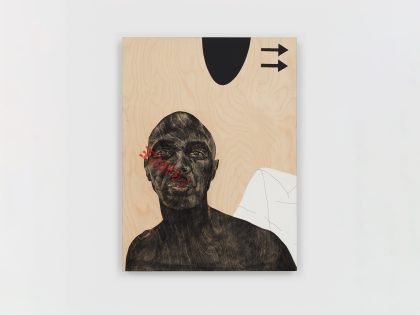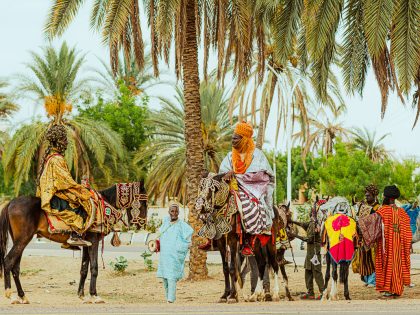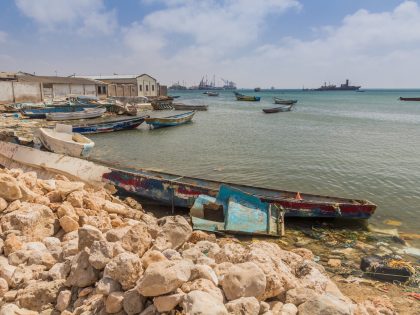“We Are All Many Things”
South African creatives of Muslim background interact matter-of-factly with their social identity. An interview with playwright and novelist Nadia Davids.

Nadia Davids. Image via her website.
- Interview by
- Sean Jacobs
- Dan Magaziner
On his single, “Arabian Gang$ter,” Youngsta CPT (government name: Riyadh Roberts) raps: “In Cape Town there’s 800,000 plus / A large population we’re starting a nation / … half of the Cape is Arabian.” The rapper forms part of a generation of South African creatives of Muslim background who interact matter-of-factly with their social identity. They don’t foreground or explain what it is like to Muslim in South Africa; it is part of the background of their lives. In a previous generation, they included the poet and literary scholar Gabeba Baderoon (who happened to have written a book about Islam’s history in South Africa from the advent of colonialism, through slavery) and the poet and writer Rustum Kozain.
Now there’s also playwright, Nadia Davids. For Davids, it started with the play “At her feet” (2002), in which one actress portrays multiple roles (mother, teenager, daughter) to make visible the complex lives of Muslim women in Cape Town. As Davids wrote at the time: “When I first began to think about writing a play about Muslim women, the world was reeling from the aftermath of September 11… I began to think very deeply about my place in the world, about the religion that I had been born into, about the country that I called home, and about the major and minor moments that had shaped me as a woman… about growing up in Cape Town, what it means to share one’s stories, and what happens when someone else’s life moves you to rethink your own.” Since that play, Davids completed a PhD. (on memory and forced removals in which her family were victims), moved to New York and then London to teach drama at Queen Mary University of London and has just returned to Cape Town. She also wrote a play about Cissie Gool, a mid-century Cape Town political activist. Now she has written her first novel, “An Imperfect Blessing,” which plot spans the late 1980s through the early 1990s and tells the story of a Cape Town family at the intersection of late Apartheid and South Africa’s political transition. It continues some of the same themes of her earlier work. This interview was conducted over email.
The novel takes place during late Apartheid and in the final period of “constitutional negotiations,” a period of intense politicization. Why write a novel about this period?
1986 to 1993 felt like a lifetime when I was a child but it was really only a handful of years and during that time we moved from being one kind of country into another. 1986 was a particularly bad year; Apartheid reached the apogee of its ruthlessness: government crackdowns, rolling states of emergency, killing with impunity, and an aggressive insistent denial from officials that any of it was happening. I wanted to write about that time and twin it with the run-up to our first democratic election. Those initial months in 1993 were intense, disorientating, exhilarating and that early nineties combination of hard-earned optimism and fraught compromise is difficult to describe today: people can be quite cynical about it (rightly so, I suppose) but it wasn’t a simple transition at all – it was bloody and dangerous and full of arguments about the right course of action. At the same time there were these moments of euphoria and fierce relief that things were changing. I come from a sort of “in-between” generation in South Africa: young enough when Apartheid ended to have not experienced the full force of its cruelty, but old enough to remember it, to have had intimate contact with it, to have witnessed what it did to the adults in my world, to understand the distortive generational damage it effected on people and communities. I came of age feeling this simultaneous fury at injustice, jubilation that is was “over”, and intense gratitude to everyone who’d gone before. The novel was a way of thinking about that time, holding it in my view, but also about telling a small family story that looked at art and activism and difficult choices, about the flow between those things, a way of asking how ordinary people were affected by that system.
I think of the book as sitting somewhere between memory and imagination, where writing is an act of remembrance, a process of turning over particular memories and then re-crafting those memories through fiction. Most of it was written when I lived away from Cape Town and I think I was trying to understand the city of my birth, its brokenness, its survival, its cruelty, its beauty, its impossible strangeness… Cape Town is an uncanny place, the past and the present are always entangled, the landscape seems to move constantly between the invitation to remember and the demand to forget and that remembering and forgetting has always been racially coded. When I write history, I always find it interesting to ask who is doing the remembering, how they are going about remembering and who would rather forget.
At the time of writing the novel there just wasn’t much fiction about that period set in the Cape Muslim community; sometimes you have to write your own history into being. It’s one way to push back against invisibility.
At another level, the novel is about how communities or families existed under Apartheid. At its heart its most vivid descriptions are of the everyday; and probably the most layered scene is that of the wedding. What does looking at regular, everyday life reveal about the dynamics of this time period?
I remember asking an aunt of mine who was in high-school during the 1976 uprising and who lived on the Cape Flats throughout the 1980s about how she coped with the constant army presence, with the incessant state violence, and her response was to shrug and say, “It was terrible, but life went on.” She wasn’t being at all dismissive; it was a very real answer about how people often live in and through conflict, how they negotiate the steady hum of a low-grade civil war, how their understanding of “normal” changes.
It’s a question that goes to the novel’s core: what was the everyday? What was ordinary? What was normal? How was it possible that the everyday functioned within the confines of an abnormal system? Yet it did. Somehow. It was normal to have everyday life infused by state violence, by racism. (For a large number of South Africans, it still is). It was ordinary to go to school and sometimes have that school shut down by the army, to have private relationships take place under the auspices of racially codified unions. But there was also resistance and so much of that resistance was precisely about refusing to normalize that immoral system.
I’m interested in the every-day, in sketching the ordinary against the backdrop of the abnormal: what it was like to ride an Apartheid bus as a child, to walk past your demolished home, to love someone who fell under a different racial classification, to go the beach not only to unwind but as an act of defiance…
You mention the wedding; it takes place when Apartheid’s laws have been dismantled and the atmosphere is celebratory, light-hearted, the focus in on food, fashion, gossip, but Apartheid and its aftermath is imprinted on everything: from the choice of venue, to the conversations people have. That chapter tries to thread together a few ideas; the everyday, the characters’ first brush with feminism, small victories, teenage alliances and rebellions, community pressures, the first conversations about the TRC. But it also tries to find the funny because I’ve always been intrigued by how humor functions under these kinds of circumstance: laughter in a politically untenable situation is a subversive refusal to be cowed, a gloriously self-affirming act.
This novel could not have taken place anywhere other than in Cape Town. Can you talk about the place of Cape Town in South African literature and in South Africa in general?
Cape Town is equal parts fascinating and infuriating: it’s at once incredibly beautiful, historically dense and famously segregated. It’s a city of dark beginnings founded through a combination of the systemized slaughter of indigenous people, a mercantile slave trade and long-term colonialism that eventually morphed into Apartheid. It was also, as a result of all these crimes, one of the most culturally and racially heterogamous places on earth by the 1800s.
It’s the sort of place that invites multiple tellings precisely because its inhabitants experience the city so differently. Capetonians do not have a shared set of fictions about the city; our imaginations reproduce our lived segregations. A rather banal example: a few days ago friend and I were reminiscing about how when we were growing up we would jokingly describe black or coloured neighborhoods through the prism of a white name: back then, Fairways was the “The Coloured Constantia,” Walmer Estate was the “Black Bishopscourt,” so was Malunga Park in Gugs, but if we then named those neighborhoods by their actual names to white South Africans, most wouldn’t know what we were talking about… I don’t know if the same things would happen today, but there is something in that, I think, about the way in which people of color knew this city. There was a deeper knowledge, a stronger sense of its difference, a more acute read of its geography. We knew more of it. We had to.
A more literary example would be this: I remember reading South African writer Stephen Watson’s lament that Cape Town had somehow resisted literary narration or that those who had attempted to narrate it had failed to capture it, to language it, and I was struck at how profoundly differently I had grown up experiencing the city. Because for me, Cape Town had always been a deeply storied place. My family ensured that the city full of inscription and dense with narrative. And those stories were always populated by people and in that telling, a web of community and place and time would be spun. Some of that storytelling-particularly around forced removal was, I think, a kind of gentle pushback at enforced discontinuity and loss, some of it was about establishing a sense of ownership in a hostile environment and some of it was just joyous. Maybe Watson was drawing a line between orality and literature; I suppose that’s possible, but I’m also a theatre person so I don’t really understand those distinctions. I wonder sometimes if theatre is actually in a fundamental way better positioned to tell South African stories… but that’s another discussion altogether.
There were certainly books set in Cape Town that I thought about when I was writing the novel, like Zoe Wicomb’s You Can’t Get Lost in Cape Town, Alex la Guma’s In the Fog of a Season’s End, and, (albeit very obliquely) J.M.Coetzee’s Disgrace. But the literary work that really forms the bedrock of the novel is Rustum Kozain’s poem The Blessing, a poem of and for Cape Town. It’s an incredibly strong evocation of the cityscape, its discontents, its difficulties, its startling beauty and breathtaking cruelty, its betrayals and promises and the novel is an attempt to respond to that poem.
So you’re right: mine is a hyper-local, tight study of Cape Town, focused on a sub-section of the city; the ruins of District Six, Obs house parties, buying gatbys, going to club matinees, cars as social space, mosques and churches, collecting money on Eid.
But it’s only one of many, many versions of Cape Town. I’m incredibly excited about the new spate of novels about the city that have been coming out for the last few years: CA Davids’ The Blacks of Cape Town, Masande Ntshanga’s The Reactive, Henrietta Rose Innes’ Green Lion.
All these works build a new literary imaginary of and around the city. Writing different versions of Cape Town, connecting neighborhoods, suburbs, communities deliberately disconnected by Apartheid, sharing stories that disrupt, comfort, confirm, engage, disorientate would go a little way to re-building what was broken. I’m optimistic that way; I’ve never not believed Michele de Certau’s perfect little aphorism, “What the map cuts up, the story cuts across.”
In a recent interview in the South African Mail & Guardian, Ebrahim Rasool, former South African ambassador to the United States, said: “South Africa has been this wonderful laboratory for Islam, which has found a high point under democracy and freedom – for Muslims to perfect the art of integration without assimilation and isolation; for Muslims to live with the wonderment of many identities and not a single religious identity. I mean, which other country would have Hashim Amla as the captain of their cricket team or Nizaam Carr coming off the reserves bench for the rugby team? These are symbols that are so taken for granted in South Africa… but do you know how it rocks the world of eight million American Muslims and 15 million French Muslims?” Your novel explores aspects of that history. What do you make of Rasool’s comments?
I think Rasool is right to be optimistic. There are few other countries as alert to Islamophobia or as instinctively and inclusively protective of its Muslim citizens as South Africa. There’s a confidence that Cape Muslim communities have about being simultaneously Muslim and South African, an ease in those identities that comes from a deep sense of belonging and historical entanglement. Which is to say that the historical matrix that allowed for “integration without assimilation and isolation” (Islam, colonialism, slavery and the struggle against Apartheid and in more shameful instances, complicity with oppression, with racism and racist practice) are all intertwined. Gabeba Baderoon’s wonderful book, Regarding Muslims explores exactly this. The novel does speak to some of those histories, but not entirely by design: that’s a by-product of a narrative in which the central characters are Muslim. If anything, I wanted to normalize Islam, normalize Muslim family life, to show that people within one family can have radically different views on love, faith, politics, to suggest that any identity is formed at a nexus of a number of different forces. Perhaps this is what Rassool means by a “laboratory.” We are all many things. How could we not be?



















